Lori Mehta, painter
The allure of painting fabric, the life-changing encounter with a cow, and a brush with Elaine de Kooning
Lori Mehta’s paintings depict an appealing world of women elegantly draped in sunlit white shirts or colorful wraps, enjoying a beachy afternoon breeze or sitting in contemplation. They evoke blissful summer days on beaches and in the water, quiet moments with an open book or mug of coffee, and an appreciation of everyday, small, and beautiful acts.
Lori has been drawing since her childhood in Connecticut but she came to painting relatively recently. She studied printmaking in college and worked as a graphic designer before stepping away from art to raise her three children in the Boston suburb of Wellesley with her husband. She took up painting about 12 years ago, beginning with art classes and workshops. Her somewhat graphic style of painting, featuring facets of even color and only a bit of gradation, has won her many awards and left galleries scrambling to show her work.
On the day Lori and I talked, she was in her home studio in Cape Cod, sitting in front of a painting in progress. The canvas was covered in a bright pink underpainting, with an upside-down sketched female figure. Lori explained that she “grounds” her paintings with red or pink or turquoise, which is less intimidating than starting with a white canvas. She often paints with the canvas upside down, saying “We're so apt to listen to the side of our brain that tells us what it's supposed to look like, whereas this way, I'm just making marks.”
Your website has a nice quote: “The object isn't to make art. It's to be in that wonderful state, which makes art inevitable.” What is that wonderful state for you and how do you get there?
I can't make it happen, and I wish I could because then I would be in that state every time I stepped into the studio. When it does happen, I forget everything that's around me and my hands just move. I sweat and I breathe heavily. I make a mess. I end up with paint on my face. Painting is spontaneous at that point because I'm not really thinking anymore.
[I start with] a very technical drawing. I spend a lot of time making sure things are anatomically correct so that when I do go to paint, I’m no longer thinking, is that shoulder anatomically correct or is the length of that leg correct? The proportions are all done, so I just put paint on.
Tell me more about your process.
One of my daughters is a ham and has no trouble modeling for me, and she will sit patiently if I want to sketch her. If I’m working on a figurative piece, the model is often either my daughter or good friend’s daughter who's younger than my daughter and is blonde.
My daughter lives in Chicago now. When she comes to visit, we spend a couple days photographing her. For some of the fabric pieces, we find a time of day where the light is nice and we go down to the beach. If I want to capture a still pose, I'll have her sit and I'll do some sketches.
The sketches are not so much to draw her, but rather to indicate color that I might not see in a photograph. For example, if I'm looking at her on the beach, there might be an area that just glares as bright orange, but I might not pick that up in a photograph. I’m more apt to see these vibrant patches of color in a live scene. Sometimes I’ll do a quick sketch, almost like a stick figure, really, and I’ll add little arrows and mark the paint color, so that’s where I want to put Indian yellow, for example.
What do you do once you have a photo you like, a sketch, and ideas about appropriate colors?
I have a print of the photo that I usually use to draw from because I can move it around freely. And I have a [wide-screen] television in my studio on which I can stream the image. I work from that because it's a larger screen than an iPad or a laptop. I draw from the printed photo and then I go back into it with the image on the television monitor for coloring.
How do you go about simplifying the subject, leading to your special, graphical style of painting?
That's in the drawing process. I simplify the entire image into shapes, often using a ruler, and then I may go back in to add things. It’s almost like paint by number. But I don't paint all the shapes that will be the same color all at once. I paint a shape and then I paint the shape next to it, and so on.
Do you have a pretty good sense of what colors you're going to use when you start?
No. Even though I have some colors in mind when I prepare a sketch, the colors are not all set at that point in time. That's why I can't mix my colors in advance. The colors I use will depend on what I start with, and then the rest of the painting will flow from that color. Although, I might go back and change colors I ultimately don’t care for.
I use a limited palette in that it’s red, yellow, and blue. For the painting I’m working on today, I’m using Indian yellow and cadmium yellow; Alizarin, crimson, and cadmium red, and turquoise and blue. When I start with these colors, I usually stick with them because, otherwise, I find it difficult to match a color that I put somewhere else unless I know what color I started with.
Are you using paint out of the tube?
I’m a purist, so I don’t use mediums. I use paint out of the tube and I use white. I use a really nice white, Williamsburg. The texture of this paint is magnificent and it's very opaque.
Do you work on one or several paintings in parallel?
Usually, I work on one painting at a time. I lose my energy for a particular painting if I walk away from it and try to come back to it. That's why I'll never paint the same thing twice. It would just be like copying. On occasion, I know that I need to go back into a painting for some reason, but it's usually minor tweaks or something might need another coat.
Were you drawing or making art as a child?
Yes. My family was very poor, and art was my outlet from very early on, growing up in Connecticut. When my great uncle Lou passed away, he left me all his art supplies. For a kid who had nothing, that was a big deal.
My grandmother would tell this story about how when I was five years old, my sister and I both wanted to color the same page in a coloring book. My sister who was older than me won, so I drew the picture of the dog to color in. But drawing wasn't valued during my upbringing. We didn’t have money, so the thought of going to art school just wasn’t feasible. Nobody in my family had gone to college. My parents’ vision for me was to be a dental hygienist.
I managed to get a full scholarship to study art. As part of the interview for the scholarship, I had to do a life drawing. I walked into the room, and there was a nude male model, which I had never seen before. I was, maybe 18, and had very little life experience, and I'm thrown in a room with a nude model. My drawing went off the page because I had never done that type of drawing before. I think that's what got me the scholarship! One of my instructors told me later that he loved that my drawing was just a segment of the body.
I was at this school in the middle of nowhere, but there were famous artists there. Lichtenstein was there for a while. Willem de Kooning had a studio there, and his wife Elaine de Kooning had a studio there too. I used to clean Elaine's studio [Wow. A short story waiting to be written.].
What did you learn from Elaine de Kooning?
I learned from seeing what was in her studio and watching what she painted and how she painted. She reminds me of a lot how Jennifer Pochinski paints. I also learned to be bold. I was timid, and at times she was demanding. She would be blunt and say, “speak up” often, so I began to. She was funny and outspoken.
You took a break from painting to raise your children. How did you find your way back to art?
We moved to Wellesley to raise our family. Being able to have our kids in private school there was something I was grateful for. But living there was just such a sharp contrast from my own upbringing that it was tumultuous for me as well. [She described arriving in Wellesley with half her head shaved and wearing Doc Martens, which at the time was not the norm in this town of Lily Pulitzer-donning fashionistas. I relate, having moved from Santa Monica to the Boston suburb of Concord, MA, at age 30, with hair my husband described as purplish, and a fondness for Doc Martens.] As a young mother, I was focused on my kids, so my own needs were set aside. Once my children were older and I began painting, it was as if I found myself again. I took classes at MassArt and workshops. Painting reminded me of who I was, not the person I was trying to be to “fit in” where we lived.
You've painted a lot of women in white shirts. What attracts you to that subject?
It's so interesting to me to break fabric down to geometric shapes and show how fabric flows. When I use a ruler to draw fabric, it takes on a whole new persona. I like painting white because of all the colors that show up in white.
I like to paint from life and sometimes I'll set up a shirt in a box in the studio with a light, and I enjoy doing it this way. I kind of get the best of both worlds, with the figure from a photograph and then the fabric from life.
We don't see faces in many of your paintings, but you can paint faces very well. Can you talk about that?
I want my work to be relatable to anyone. The moment you put a face in there, some people are going to have a harder time relating. Some of the nicest compliments I get are when people say, “That reminds me of my daughter when we were on the beach,” because they don't see a face.
You’ve recently started making paintings of your grandson. Is it different painting your grandson than the other paintings you create with your daughter as the model?
Yes. When I create a painting with Emma, my daughter, as the model, I think I may sell it, or maybe not. Sometimes they become very dear to me, and I keep them. But in general, she's my model. When I'm painting my grandson Miles, I know I'm not going to sell any of them because they are for me or my daughter. They are legacy pieces, so the feeling is very different.
There's a lot of love in those paintings. When you paint someone, you get to know them intimately. I know how his leg turns and the little features of his hands.
Your painting Inner Glow received many awards. When you were painting it, did you sense it was a special piece?
I didn't. I started painting it right before the pandemic and finished it when we went into lockdown. That was a turning point piece for me, with how I broke down the hands and introduced a bit more daring color, such as the green in the hands. There was something going on inside of me about the pandemic that came through in that painting.
You recently painted a cow for the Cow Parade. Was it the first time you've painted on a three-dimensional surface?
Yes.
What was that like?
It was so much fun. It was life-changing for me, which I know sounds weird. When I was asked to paint the cow, it was a day after a very dear friend passed away from cancer. I had a lot I needed to get done. But if Dana-Farber asks me to do something, I’m going to do it. I decided to shut everything else down. It was the most freeing thing to have an excuse to do nothing but paint this cow to raise money for cancer research. At the time, my daughter and her husband and my grandson moved in with us because their apartment flooded. It was challenging to find time to paint this cow in the basement while my grandson would be standing at the top of the stairs calling for me.
Were you given any guidance about what to paint on the cow?
No, but I had to provide a drawing of what the cow would look like. But I didn't have the cow there with me yet. This is going to make you laugh: I asked my husband to get on the floor on all fours with his head bent down, and I draped fabric over him and photographed him. [She smiles. The things we do for love and art.]
The cow is now in front of the Copley Society of Art, where I'm a member [it has since found a permanent home elsewhere].
What did you learn from that experience?
What I learned is psychological; it was not about painting a three-dimensional object. It's about looking after myself, and not letting the pressure get to me. I feel very, very fortunate that I've had as much success as I have had, but it's been a whirlwind.
While I sometimes feel pressure to get work to galleries, I'm very, very grateful. I never thought I'd have the kind of success that I have had. But I also know that if I want to grow and get better, I can't just paint what sells.
Galleries will ask for more of a specific painting, but I have to paint whatever image happens to move me at that particular time in my life. With the cow, I realized I can drop everything and just do what I want to do. What's the worst that could happen? I'm not doing this just to make money. I'm doing this to improve my craft and become a better artist.
What do you want to get better at?
Overcoming the feeling that I can never finish a painting. I'll enjoy the completed piece for about 24 hours and then I'll start to criticize it and wish I had done some aspect of it differently. But if I go back into that painting, it looks overworked, so I tend to not do that.
I had a lot of creativity pent up inside of me for many years while I was raising my kids. What I've done so far, it's the tip of the iceberg. I have so many more ideas. When I can paint without too much struggle, I know I have to move on. If putting the paint down comes too easily to me, it's not interesting to me anymore. I was at a fabric store the other day, looking at bolts of fabric, and saying to myself, “Just think of what I could do with this!”
Do you have a couple of tips you can give a beginner painter like me, besides just keep painting?
Take a couple of workshops with people you admire, and learn value. Value is huge. Once you learn how to mix colors and value, you can do anything you want. [Value is the lightness or darkness of a given hue.]
The other thing I would say is, after you've taken those classes, understand that's how that particular artist does something, but it’s not the only way to do it.
Have you ever had a mentor for your art?
I did study with Catherine Kehoe, and my painting ability skyrocketed under her guidance.
It was a lot of learning the basics, such as mixing color and values. She was tough, but in a way I liked. I wanted to know what I was doing wrong, and she would tell me in a sarcastic way that I found funny. We meshed because I didn't take it to heart.
What is your state of mind when you are painting?
Sometimes people expect artists to have deep angst that they put into their painting, but I don't have that angst. It makes me light and airy and happy and joyous to paint. I have plenty of angst in my life. But when I paint, there’s none of that. I’m very grateful that at this point in my life I'm able to do this and that it's something I'm going to be able to do until I'm a hundred years old if I'm lucky enough to live that long.
Do you have other creative outlets besides painting?
It's going to sound so corny. I paint stones. If I'm just not in the groove to paint, I pick up my paint pens and paint stones. Then I hide them around the neighborhood for people to find, or I put them in peoples’ mailboxes if I know they like a particular thing. It makes me feel good. [I’d be happy if I found a Lori Mehta rock in my mailbox… hint, hint].
Your paintings have been on book covers.
Yes! I'm working on one now for a book publisher in Spain. The first cover that featured one of my paintings was for a memoir of a man who worked in the Reagan administration. They found me through Instagram. The second book cover came about when I was contacted randomly from a company in Germany. It was for a Korean book that was being translated into German.
If you could paint a cover for any book, which book would you choose?
Dogs Don’t Bite When a Growl Will Do, which I have given to many people when they have lost a loved pet.
If you could trade paintings with any artist living or dead, what artists would you want to trade paintings with?
Linda Christensen. She's a painter in California. We talk about what’s happening in our lives and how it’s coming out in our paintings.
What's your favorite piece of art that you created?
It’s the front of a face. It was a turning point piece, in that I took a leap and my artwork has changed, and usually I keep those. I don't have a name for it because I own it.
What’s the most memorable meal you’ve had?
Recently we were in Denmark, at a restaurant called Marchal. My husband and I decided we would split everything so we could taste many things. We ordered ravioli, and we were served one!
We were doing all we could not to burst into laughter. It was served in this massive bowl. But it was the best damn lobster ravioli! It deserved the stage of the big plate.
If you could host a dinner party with six people, living or dead, who would you invite?
My husband (he’s always got my back), my brother (he died when he was 6 and I would like to know who he was), my grandmother (she encouraged my art when no one else did. I would like her to see that I got back to it), my therapist (so curious what he is like without those damn boundaries!). Also, a dear friend who I have never met, Julia. We “met” when she first purchased a painting of mine years ago. When we talk, we are connected as if I have known her for years, but I may never meet her. Julia has ALS. She is young, brilliant (a doctor), and funny as hell! We now speak weekly. I would go see her, but she is uncomfortable seeing people in her condition. Her bravery and humor as she faces this insidious disease is like nothing I have ever experienced before. She is a gift. Last but not least, you, Amy. I am very uncomfortable talking about myself, however your thoughtful questions got me out of my own head. Given that you enjoy cooking as well as writing it only seems fair that we should join one another over a fine meal and get to know each other a bit more [I’m deeply honored].
Palate & Palette menu for Lori Mehta
Here’s what I would serve if Lori and her husband came to dinner, which they are invited to do:
Corn and lobster tacos
Charred snap peas with mint and feta cheese
Beets with fresh cherries and Castelvetrano olives
Peach and strawberry galette
Where to find Lori Mehta (and you should!)
Lori Mehta Art
@lorimehtaart
Copley Society of Art, 158 Newbury St, Boston
Edgewater Gallery, 6 Merchants Row and 1 Mill St., Middlebury, Vermont
Edward Dare and Sandpiper Gallery, 31 Broad St., Gallery Row, Charleston, South Carolina
Maine Cottage






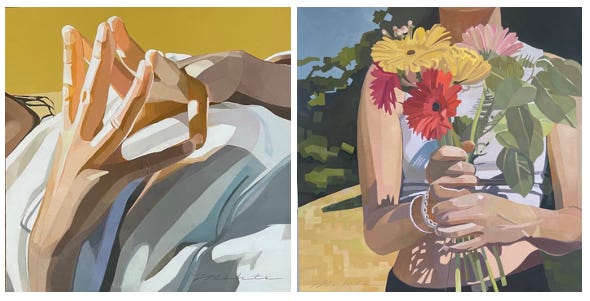


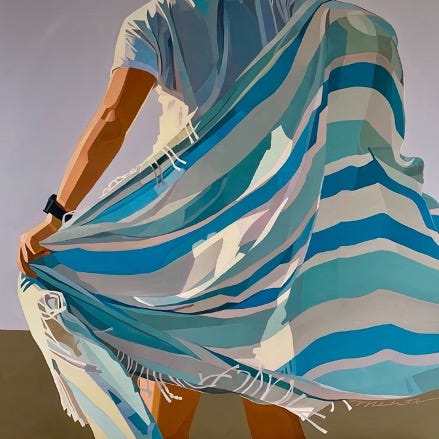


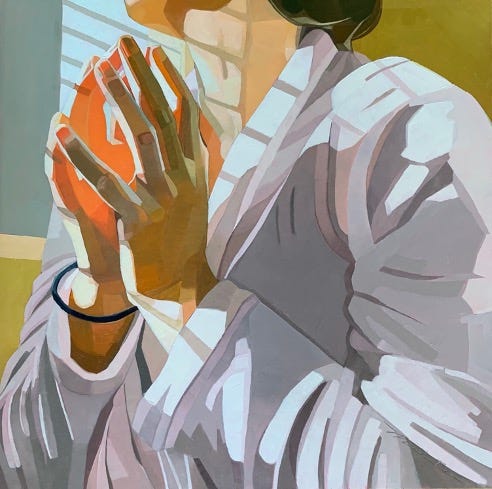

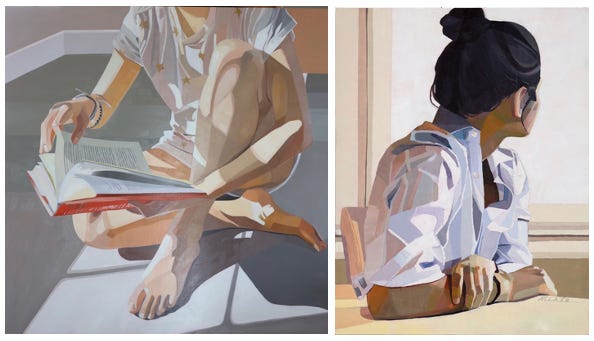



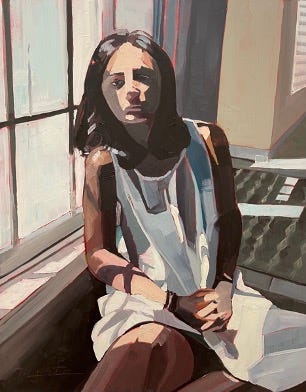

I love the way she renders the women as thoughtful, beautiful and sensual without being sexualized. Makes sense when the model is your daughter. The abstract treatment of light and fabric reminds me somewhat of Dali's 'Girl at the Window'. Wish the cows were available in miniature statues!
Nice interview Amy! I can see the early graphic influence. It's good to have family members who will pose for you!